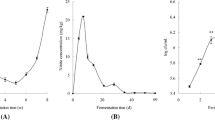Abstract
To identify and characterize the microbial communities in gochujang, a traditional Korean fermented food, the viable cell numbers of total bacteria, halophilic bacteria, fungi, yeasts, halophilic yeasts, and lactic acid bacteria from 7 homemade gochujang samples produced in the Sunchang area and 5 commercial gochujang samples were counted. The variety of microflora in the gochujang samples was evaluated by identifying the isolates via DNA sequence analysis. The viable cell numbers of total bacteria were determined to be in the range of 6–7 log CFU/g, which were higher than those of yeasts. Neither lactic acid bacteria nor fungi were detected in either type of gochujang after aging. A total of 7 genera and 31 species of microorganisms were identified in the gochujang: 29% was identified as Bacillus velezensis, as a major microorganism in gochujang. Under halophilic conditions, Oceanobacillus spp. was detected for the first time.
Similar content being viewed by others
References
Shin DH. Survey on preparation method of traditional home made gochujang (fermented hot pepper-soybean paste). Korean J. Diet. Culture 10: 427–434 (1995)
Ko BK. Preparation and physicochemical properties of abalone gochujang. PhD thesis, Chonnam National Universuty, Gwangju, Korea (2006)
Choi JY, Lee TS, Noh BS. Quality characteristics of the gochujang prepared with mixture of meju and koji during fermentation. Korean J. Food Sci. Technol. 32: 125–131 (2000)
Cho DH, Lee WJ. Microbiological studies of Korean native soysauce fermentation: A study on the microflora of fermented Korean meju loaves. J. Korean Soc. Agric. Chem. 13: 35–42 (1970)
Lee SS. The fungi inhabiting Korean traditional meju (meju fungi). Soy Sauce Institute, Yeung Nam University, Daegu, Korea (2000)
Choi KK, Cui CC, Ham SS, Lee DS. Isolation, identification, and growth characteristics of main strain related to meju fermentation. J. Korean Soc. Food Sci. Nutr. 32: 818–824 (2003)
Kim SR, Huh DJ. Studies on improvement of traditional condiment. Natl. Def. Sci. Ins. 56: 9277–9281 (1954)
Han YS, Park BD. Studies on the manufacturing of soy-sauce (part 1); Aspergillus oryzae from ordinary meju and gokja research report. Cen. Ind. Res. Ins. 7: 51–56 (1957)
Kang MJ, Kim SH, Joo HK, Lee GS, Yim MH. Isolation and identification of microorganisms producing the soy proteinhydrolyzing enzyme from traditional meju. J. Korean Soc. Agric. Chem. 43: 86–94 (2000)
Lee JS, Yi SH. Isolation, identification, and cultural conditions of yeast from traditional meju. Korean J. Appl. Microbiol. Biotechnol. 25: 435–441 (1997)
Shin DH. Functionality of soy fermented food and changes of manufacturing technology. Korea Soybean Digest 21: 49–63 (2004)
Yoon JH, Lee ST, Park YH. Inter-and intraspecific phylogenetic analysis of the genus Nocardioides and related taxa based on 16S rDNA sequences. Int. J. Syst. Bacteriol. 48: 187–194 (1996)
Gürtler V, Stanisich VA. New approaches to typing and identification of bacteria using the 16S–23S rDNA spacer region. Microbiology 142: 3–16 (1996)
White TJ, Bruns TD, Lee SB, Taylor JW. Amplification and direct sequencing of fungal ribosomal DNA for phylogenetics. pp. 315–322. In: PCR Protocols: A Guide to the Methods and Applications. Innis MA, Gelfand DH, Sninsky JJ, White TJ (eds). Academic Press, Inc., New York, NY, USA (1990)
Thompson JD, Higgins DG, Gibson TJ. CLUSTAL W: Improving the sensitivity of progressive multiple sequence alignment through sequence weighting, position-specific gap penalties, and weight matrix choice. Nucleic Acids Res. 22: 4673–4680 (1994)
Saitou N, Nei M. The neighbor-joining method: A new method for reconstructing phylogenetic trees. Mol. Biol. Evol. 4: 406–425 (1987)
Kumar S, Tamura K, Jakobsen IB, Nei M. MEGA2: Molecular evolutionary genetics analysis software. Bioinformatics 17: 1244–1245 (2001)
Shin DH, Kim DH, Choi U, Lim DK, Lim MS. Studies on the physicochemical characteristics of traditional gochujang. Korean J. Food Sci. Technol. 28: 157–161 (1996)
Lee JS, Choi YJ. Screening and characterization of osmotolerant and gas-producing yeasts from traditional deonjang and gochujang. Food Biotechnol. 5: 54–58 (1996)
Kim JS, Choi SH, Lee SD, Lee GH, Oh MJ. Quality change of sterilized soybean paste during its storage. J. Korean Soc. Food Sci. Nutr. 28: 1069–1075 (1999)
Kwon OJ, Kim JK, Chung YG. The characteristics of bacteria isolated from ordinary Korean soy-sauce and soybean paste. Agric. Chem. Biotechnol. 29: 422–428 (1986)
Jung YS. Microbiological studies of soy sauce: Identification and isolation of bacteria from traditional soy sauce. Korean J. Microbiol. 1: 30–35 (1963)
Yoo SK, Cho WH, Kang SM, Lee SH. Isolation and identification of microorganisms in Korean traditional soybean paste and soybean sauce. Korean J. Appl. Microbiol. Biotechnol. 27: 113–117 (1999)
Sneath PA, Mair NS. Bergey’s Manual of Systematic Bacteriology. Vol. 2. Williams & Wilkins, Baltimore, MD, USA. pp. 1105–1139 (1986)
Arbige NV, Bulthuis BA, Schultz J, Crabb D. Fermentation of Bacillus. pp. 871–895. In: Bacillus subtilis and Other Gram-positive Bacteria; Biochemistry, Physiology and Molecular Genetics. Sonenshein AL, Hoch JA, Losick, R (eds). Wiley-Blackwell, Hoboken, NJ, USA (1993)
Katz E, Demain AL. The peptide antibiotics of Bacillus: Chemistry, biogenesis, and possible function. Bacteriol. Rev. 41: 449–474 (1977)
Banwart GJ. Basic Food Mirobiology. 2nd ed. Chapman & Hall, New York, NY, USA. pp. 461–462 (1989)
Ruiz G. Bacillus velezensis sp. nov., a surfactant-producing bacterium isolated from the river Velez in Malaga, southern Spain. Int. J. Syst. Evol. Micr. 55: 191–195 (2005)
Author information
Authors and Affiliations
Corresponding author
Rights and permissions
About this article
Cite this article
Jang, SJ., Kim, YJ., Park, JM. et al. Analysis of microflora in gochujang, Korean traditional fermented food. Food Sci Biotechnol 20, 1435–1440 (2011). https://doi.org/10.1007/s10068-011-0197-0
Received:
Revised:
Accepted:
Published:
Issue Date:
DOI: https://doi.org/10.1007/s10068-011-0197-0




